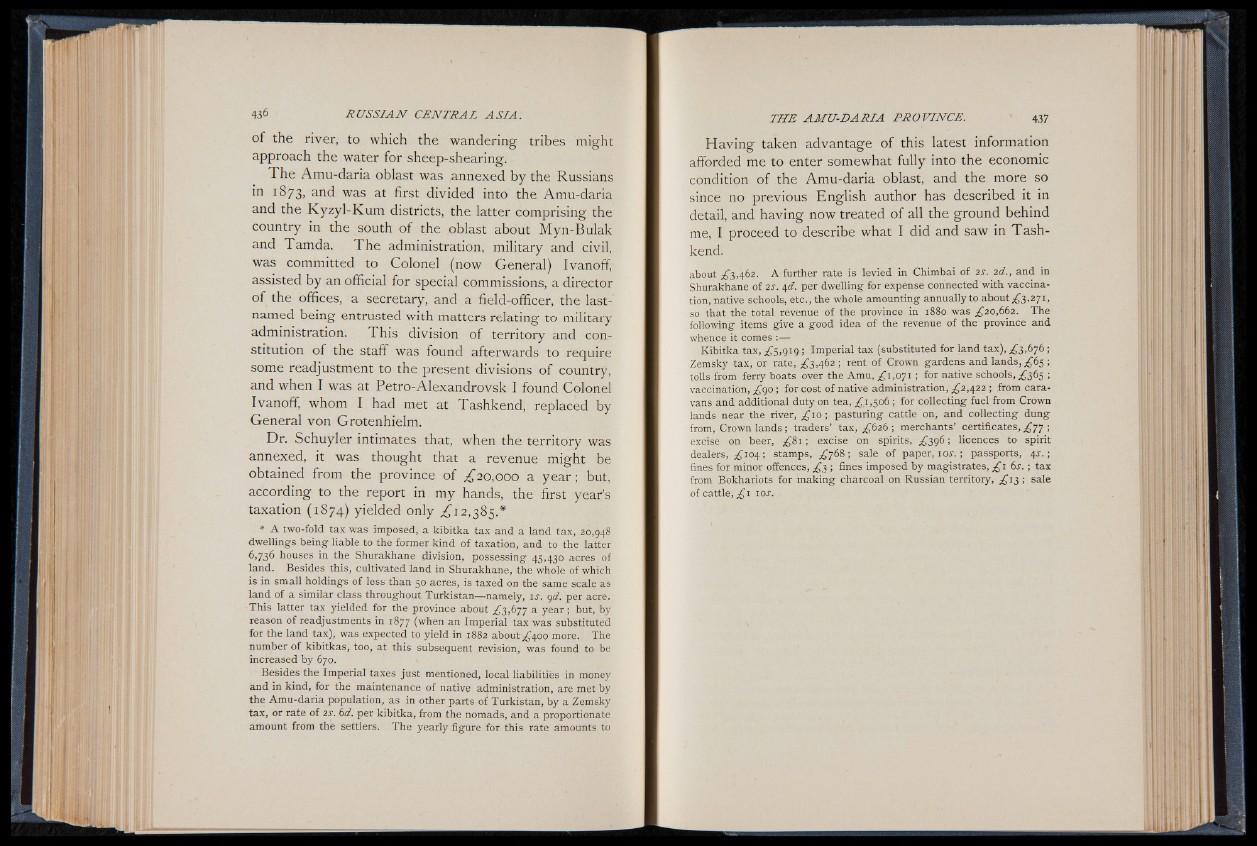
of the river, to which the wandering tribes might
approach the water for sheep-shearing.
The Amu-daria oblast was annexed by the Russians
in 1873, and was at first divided into the Amu-daria
and the Kyzyl-Kum districts, the latter comprising the
country in the south of the oblast about Myn-Bulak
and Tamda. The administration, military and civil,
was committed to Colonel (now General) Ivanoff,
assisted by an official for special commissions, a director
of the offices, a secretary, and a field-officer, the last-
named being entrusted with matters relating to military
administration. This division of territory and constitution
of the staff was found afterwards to require
some readjustment to the present divisions of country,
and when I was at Petro-Alexandrovsk I found Colonel
Ivanoff, whom I had met at Tashkend, replaced by
General von Grotenhielm.
Dr. Schuyler intimates that, when the territory was
annexed, it was thought that a revenue might be
obtained from the province of .£20,000 a year; but,
according to the report in my hands, the first year’s
taxation (1874) yielded only £’12,385.*
* A two-fold tax was imposed, a kibitka tax and a land tax, 20,948
dwellings being liable to the former kind of taxation, and to the latter
6,736 houses in the Shurakhane division, possessing 45,430 acres of
land. Besides this, cultivated land in Shurakhane, the whole of which
is in small holdings of less than 50 acres, is taxed on the same scale as
land of a similar class throughout Turkistan— namely, u . gd. per acre.
This latter tax yielded for the province about .£3,677 a y e a r ; but, by
reason of readjustments in 1877 (when an Imperial tax was substituted
for the land tax), was expected to yield in 1882 about £400 more. The
number of kibitkas, too, at this subsequent revision, was found to be
increased by 670.
Besides the Imperial taxes just mentioned, local liabilities in money
and in kind, for the maintenance of native administration, are met by
the Amu-daria population, as in other parts of Turkistan, by a Zemsky
tax, or rate of 2s. 6d. per kibitka, from the nomads, and a proportionate
amount from the settlers. The yearly figure for this rate amounts to
Having taken advantage of this latest information
afforded me to enter somewhat fully into the economic
condition of the Amu-daria oblast, and the more so
since no previous English author has described it in
detail, and having now treated of all the ground behind
me, I proceed to describe what I did and saw in Tashkend.
about £3,462. A further rate is levied in Chimbai of 2s. 2d., and in
Shurakhane of 2s. 4d. per dwelling for expense connected with vaccination,
native schools, etc., the whole amounting annually to about £3,271,
so that the total revenue of the province in 1880 was £20,662. The
following items give a good idea of the revenue of the province and
whence it comes :—
Kibitka tax, £5,919 ; Imperial tax (substituted for land tax), £3,676;
Zemsky tax, or rate, £3,462 ; rent of Crown gardens and lands, £65 ;
tolls from ferry boats over the Amu, £1,071 ; for native schools, £365 ;
vaccination, £90 ; for cost of native administration, £2,422 ; from caravans
and additional duty on tea, £1,506 ; for collecting fuel from Crown
lands near the river, £ 10 ; pasturing cattle on, and collecting dung
from, Crown lands ; traders’ tax, £626 ; merchants’ certificates, £ 7 7 ;
excise on beer, £ 8 1 ; excise on spirits, £396; licences to spirit
dealers, £104; stamps, £768; sale of paper, 10s. ; passports, 4 J .;
fines for minor offences, £3 ; fines imposed by magistrates, £ 1 6s . ; tax
from Bokhariots for making charcoal on Russian territory, £13 ; sale
of cattle, £ 1 10s.